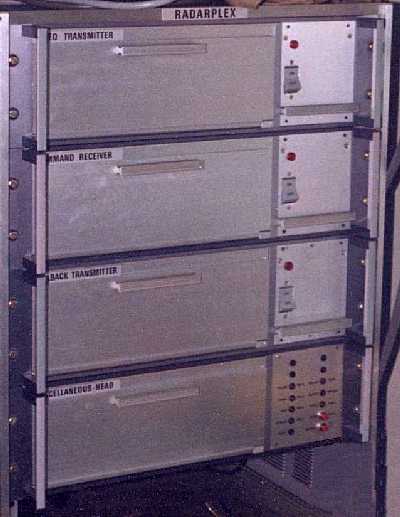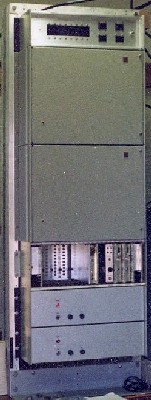 |
|
Radarplex Head Site Rack
|
In the mid nineteen-seventies, Alf West and Noel Schrumm developed a system for remotely controlling WF44 radars in the weather-watch role which was called Radarplex. It used only a two-way voice bandwidth circuit and a one-way video bearer to link the radar head and the operations room.
Normal weather-watch displays were provided in the operations room, together
with a Bureau-developed Remote Control Console . A Radarplex
rack at each location acted, in effect, as an interface between the radar equipment
and the communications circuits.
The video bearer was a Bureau-owned Collins 8GHz microwave link on the Laverton/Melbourne,
Mt. Stuart/Townsville and Cape
Range/Learmonth systems. The Mt. Kanigan/Brisbane system used a broadband
bearer rented from the Telecommunications Commission. The voice-bandwidth circuit
was normally a rented private telephone line but was carried on a subcarrier
on the microwave link system installed on the Cape Range/Learmonth
system.
There was no distance limitation over which the system could be used; the longest link used was between Brisbane and Mt Kanighan, (about 120 miles). though experimentally the control functions were tested once from Melbourne to Mt Kanighan!(2)
Five systems were installed;
Laverton/Melbourne Regional Office VIC. installed February 1976
Mt. Kanigan/Brisbane Regional Office QLD. installed August 1976
Mt.
Stuart/Townsville QLD. installed November 1976
Cape Range/Learmonth W.A. installed August/September 1978
Brisbane Airport/Pinkenbar QLD. installed November 1987
The last system was installed using an optical-fibre link for the video circuit. Due to the probability of "back-hoe brown-outs" (as the locals called failures caused by someone cutting the fibre) a low power 10.5 GHz microwave link was installed as a backup circuit. This facility was used a number of times over the first three years!
 |
|
Collins MW518 microwave link
|
The Collins microwave link used from Cape Range
to Learmonth didn't have direct line of sight from end to end. For this
reason a passive repeater, consisting of two dishes back to back on a short
tower joined by a length of waveguide was sited on the edge of the escarpment
to ensure a good signal path.
References
(1) EH355 RADARPLEX Technical Handbook
(2) A.L.West (private communication)